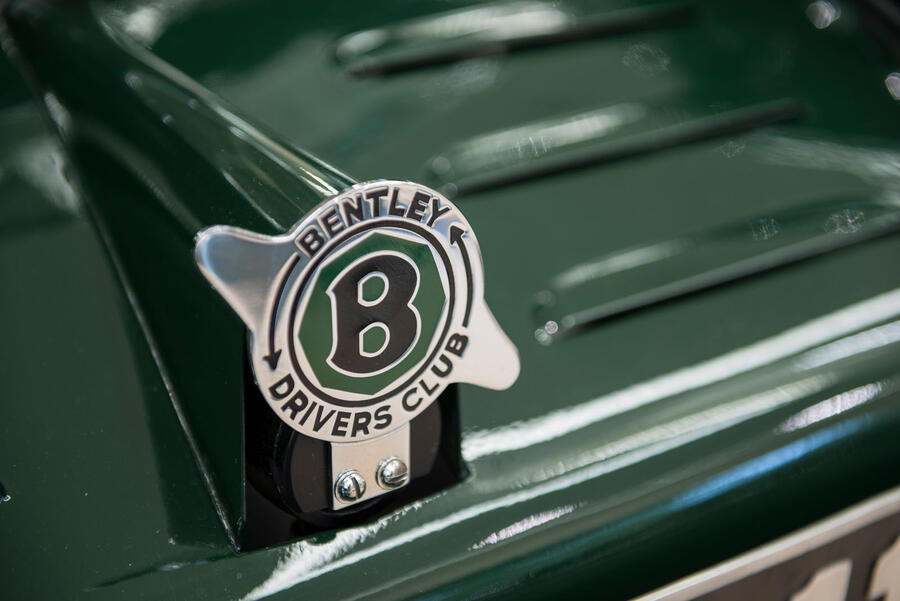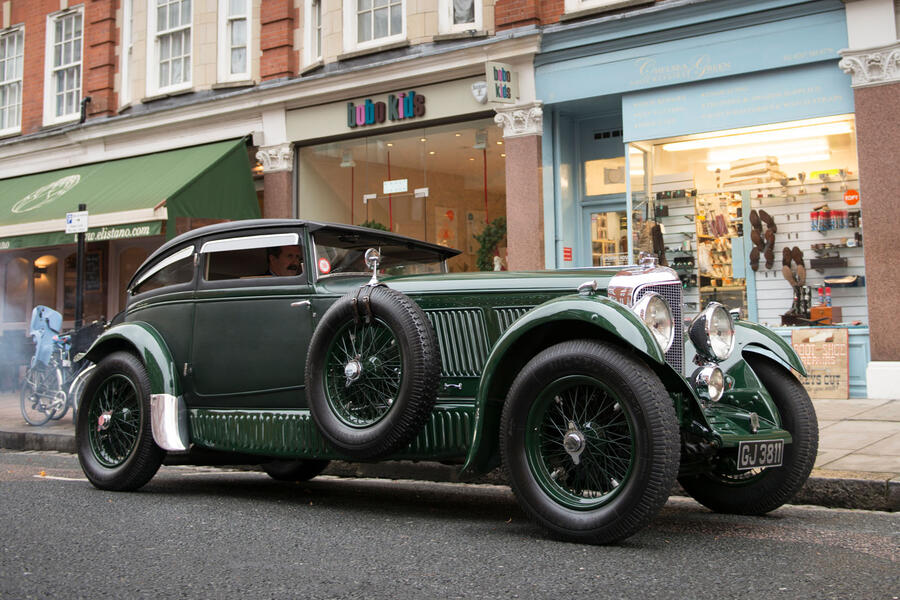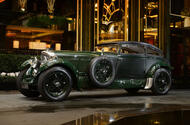The Bentley ‘Blue Train Special’ inspired the new EXP 15 concept – we experience it
Bentley has unveiled the EXP 15, a new concept that provides a scintillating first look at its new era. A high-riding limousine, it actually takes inspiration from the ‘Blue Train’, a special driven by Bentley Boy Woolf Barnato in the 1930s.
In this feature from 2014, Steve Cropley visits some of Barnato’s favourite haunts in the Blue Train. This is what it feels like to thread it through London’s side streets…
The Bentley Boys are back in town
The point of owning a special car, owners say, is that you can use it to do special things. However, for Woolf Barnato, 35-year-old double Le Mans winner and owner of Bentley Motors in the spring of 1930, the usual order of things was reversed: he had an activity in mind but needed the car. What he did about that created, over the next 84 years, the curious tale of the Bentley Blue Train.
Barnato had inherited his father’s South African diamond mining fortune and was a prominent member of London’s car-mad social scene. The task he set himself had already been well publicised. Both a Rover and an Alvis had recently raced and beaten the famous Blue Train, the French express known for assisting England’s wealthy to ‘winter’ on the French Riviera. However, each had merely beaten the train by minutes, and from the bar of the Hotel Carlton in Cannes, Barnato decided a Bentley could do much better. He bet £100 that he could leave with the Blue Train and be parked outside his London club by the time it reached Calais. On 13 March, with his friend Dale Bourne riding shotgun, he set off just before 6pm in his Bentley Speed Six to prove it.
Near Lyons the pair was slowed by heavy rain. At Auxerre they lost time searching for a fuelling point. Further north they encountered dense fog and burst a tyre, but they still made the Boulogne cross-channel ferry at 10.30am and reached London in the early afternoon, parking outside the Conservative Club in St James’s Street four minutes before the Blue Train steamed into Calais station at 3.54pm. Barnato collected his £100 but was fined considerably more by furious French authorities for racing on public roads. And in a fascinating link between law enforcement and commerce, the French organisers also managed to prevent Bentley from exhibiting cars at the Paris Salon later that year – but nothing could affect the fame of the legendary ‘Blue Train’ Bentley.

For decades it was presumed that Barnato’s Cannes-London Bentley was the magnificent Gurney Nutting-bodied Speed Six Sportsman’s Coupé you see here, owned by Bruce and Jolene McCaw of Washington and imported temporarily to the UK last year for various anniversaries and re-enactments. As late as 2005, the coupé was still being portrayed as the authentic record-breaker, though by then doubts had surfaced.
New research by the owner revealed the truth: Barnato had raced across France in an HJ Mulliner-bodied Speed Six saloon. His notes had referred clearly to a saloon that carried fuel cans in its boot – and the coupé didn’t have one. In fact, Barnato had taken delivery of the Gurney Nutting two-door two weeks later and christened it, in all innocence, the Blue Train Special in honour of his achievement.
All this the McCaws established beyond doubt. Then, to complete the job, they found, bought and restored the original Speed Six saloon. Nothing, however, could detract from the Gurney Nutting coupé’s value (£6 million and counting) or unique appeal – which is why we came to be driving it by kind permission of the indulgent owners through London’s pitiless traffic.
Our plan was to do a Barnato heritage tour of London, starting at the famous Jack Barclay dealership in Berkeley Square (the world’s largest and oldest Bentley emporium) and visiting four of the great man’s haunts before arriving at the famous Savoy Hotel, where Barnato and his Bentley Boy friends were regulars. Their fame was such that, to this day, the Savoy’s skilled bar staff can still reach into their famed recipe book and mix you a Woolf Barnato cocktail.

It was spitting when we assembled at 9am, but the dullness outside only served to make the Blue Train Special gleam more brightly under Jack Barclay’s showroom lights. The Gurney Nutting coupé is shorter and lower than the regulation sixcylinder 6½ Litre from which it is derived, but it still dwarfed the longest modern in the showroom, with its immense wire wheels and a roof line, despite being ‘chopped’ in modern parlance, well above my head. Imposing is the word. Roughly a third of 6½ Litres were Speed Sixes – hotter because of their higher compression ratios, twin SU carburettors and performance camshafts. They were rated at 180bhp at 3500rpm, compared with 147bhp for the standard 6½. The successful racing versions went well beyond 200bhp.
Against a modern straight six, this is not a smooth engine, but then you’ll be pushed to find a modern six so big. The enormity of its rotating masses (capacity is 6597cc, or well over a litre per cylinder) and the ultra-long stroke of 140mm, compared with the 100mm bore, give it a healthy rumble.
It’s extremely torquey, though – one of those engines that seems to develop 100lb ft of torque when merely idling, which it can do very slowly if you set the timing and mixture using the elegant steering wheel levers. Our driver, Richard Charlesworth (whose official position as Bentley’s director of royal and VIP relations meant he wouldn’t be doing much rabbiting about his day job), is perhaps the firm’s foremost expert at driving cars of the ‘WO’ era, and he took the wheel.
We headed first for Grosvenor Square, half a mile away, where Barnato’s elegant home at No 50 stands at the south-eastern corner, farthest from the looming US Embassy that occupies the western end 400 metres away. In front of the house there’s an inviting-looking parking apron known in period as Bentley’s Corner, and we were worried as we bumped the mighty car over kerbs on to what today is most definitely a footpath, expecting at any second platoons of machine gun-toting security men to arrive, wanting to know our intentions and political leanings.
![]()
No one came. No one, that is, except for curious tourists by the dozen. It went to prove what any vintage car owner will tell you: the general public is interested in and entirely unthreatened by old cars and has an instinctive liking for their antiquity. While they swirled, we took a minute to savour the elegance of the surroundings before heading back into the traffic, peering through the slit screen, over the louvred bonnet, past the dinner-plate headlights and on to the road.
Driving a car like this in London is something you’d never manage if you hadn’t established familiarity with it in easier-going traffic. First, there’s the ultra-heavy, unassisted steering and 45ft (my estimate) turning circle to contend with. If you only ever drive moderns, you forget what a huge part of driving time is taken up with clutch and transmission management. Sure, the engine is huge and flexible, but any gearchange, up or down, requires a time-consuming double shuffle (one-pause-clutch-clunk-two) that simply can’t be banged through, no matter how many white vans are snapping at your rear. Same for the brakes. They’re powerful, but the car’s a three-tonner. Start slowing before you have to, that’s the rule.
Yet it’s comfortable. Not exactly spacious, but it has those enveloping bucket seats of the early days of motoring and room enough to stick your legs more or less straight out in front. Despite the lack of independent suspension at either end, the Bentley’s weight simply mashes most bumps into submission, and with such a vast wheelbase, fully a metre longer than some family cars, the big beast simply never pitches.
We hunted for a while before finding our next landmark, the old Gurney Nutting coachbuilding shop in Elystan Street, behind the King’s Road, where the Blue Train coupé’s special body was reputedly built.
At first we saw only blocks of f lats, but suddenly there it was, small, perfectly placed and venerable enough to be a coachbuilder’s shop. Our hearts leapt. Then it was back through Berkeley Square again – past the Morton’s Club greatly favoured by Barnato and his chums – and into St James’s Street, where we parked outside the old Conservative Club. Again, the confidence of the old-car owner came to the fore; we must have stood there for 15 minutes, funnelling taxis and tourist buses from two lanes into one while various snappers (moving and still) did their stuff. We were never hassled.
We’d travelled five or six miles in as many hours, so it was well into the afternoon by the time we turned from The Strand into the unique entrance of The Savoy, greeted instantly by the topper-toting miracle men who have the impossible job of controlling the congested forecourts of places such as this, yet accomplish it for years on end and nearly always with a smile.
![]()
They squeezed both our Gurney Nutting coupé and our snappers’ Mulsanne saloon (which looked rather well beside it) into a specially cleared corner, clucking over the Blue Train as if it were one of the greatest cars in the world and not minding that we deposited some rather horrible coolant on their immaculate floor. It is one of the world’s greatest cars, of course, but these are men for whom the most lurid Bugatti Veyron is merely four wheels and an engine.
In the Cocktail Bar – thronged, incredibly, by people who looked perfectly comfortable there – the head barman produced the venerable Savoy Cocktail Book (which has lived behind the same bar since the ’30s) and opened it at the right page. We could have had The Bentley or The Woolf Barnato but, after discussion, opted for the former, consisting of half-and-half Dubonnet and extremely upmarket calvados. I’d like to say it was delicious, but the truth is it was an acquired taste and none of us was ever likely to have the time or money to put the work in. Still, it seemed to go perfectly with the quality and grandeur of the two cars outside, new and old, and I’m pretty confident Woolf Barnato would have thought so, too.
Source: Autocar
